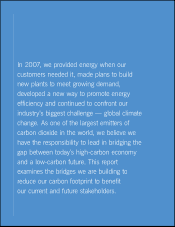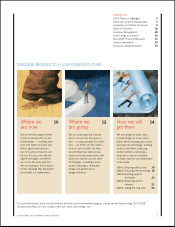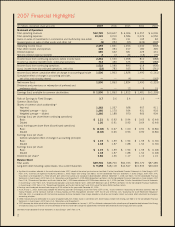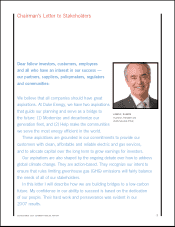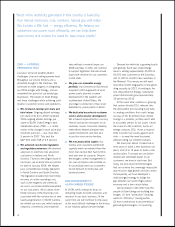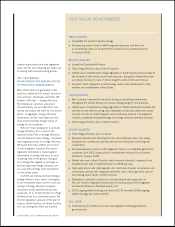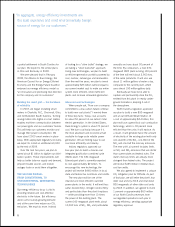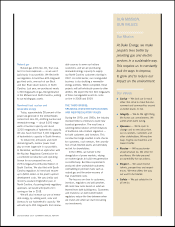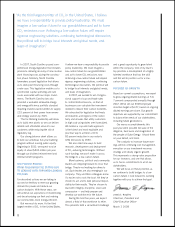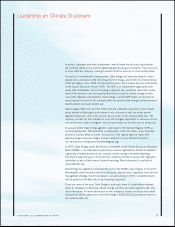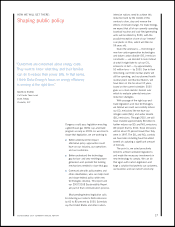Duke Energy 2007 Annual Report Download - page 10
Download and view the complete annual report
Please find page 10 of the 2007 Duke Energy annual report below. You can navigate through the pages in the report by either clicking on the pages listed below, or by using the keyword search tool below to find specific information within the annual report.
8
In 2007, South Carolina passed com-
prehensive energy legislation that includes
provisions allowing recovery of new nuclear
plant financing costs during the construc-
tion phase. Similarly, North Carolina
lawmakers passed legislation that allows
us to seek plant financing costs through
a rate case. This legislation enables us to
synchronize capital spending and rate
cases associated with our major invest-
ments. The North Carolina law also
provided a workable renewable energy
and energy efficiency portfolio standard
requiring investor-owned utilities to supply
12.5 percent of their power from renew-
able energy sources by 2021.
This far-thinking leadership will allow
us to build new plants so we can deliver
reliable and affordable service to our
customers while reducing the risk of
regulatory lag.
Our strong balance sheet allows us
to fund our ambitious five-year building
program without issuing public equity.
Beginning in 2010, we expect to raise
equity of about $200 million per year
through our dividend reinvestment and
internal benefit programs.
THE FOURTH BRIDGE:
FROM FOLLOWING THE STATUS QUO
TO LEADING WITH FORWARD-LOOKING
POLICIES
I’ve described actions we are taking in
our service territory to meet our growing
demand for power and reduce our
carbon footprint. With these steps, we
will achieve our aspirations of modernizing
and decarbonizing our fleet and making
our communities more energy efficient.
But we must do more. As the third
largest emitter of CO2 in the United States,
I believe we have a responsibility to provide
policy leadership. We must imagine a
low-carbon future for our grandchildren
and act to lower CO2 emissions now.
Achieving a low-carbon future will require
rigorous engineering solutions, continuing
technological discoveries, the political will
to bridge local interests and global needs,
and leaps of imagination.
In 2007, we worked to win Congres-
sional support of cap-and-trade rules
to control GHG emissions, so that all
businesses can calculate the investment
needed to reduce their carbon footprints.
We advocated for legislation that treats
all industries and regions of the nation
fairly and ensures that utility customers
in high coal-using states aren’t penalized.
We believe a cap-and-trade approach
is the fairest and most equitable and
practical way to achieve a 60 to
80 percent reduction in our nation’s
GHG emissions by 2050.
We also need new ways to fund
research, development and deployment
of CO2-reducing technologies. Without
such funding, we won’t make it across
the bridge to a low-carbon future.
More business, political and community
leaders are stepping forward to cross that
bridge. They’re not waiting for others to
act. Such leaders are also emerging in our
company. They and their colleagues know
it’s easier not to rock the boat. Yet they’ve
chosen to act and to take personal respon-
sibility for their results. They’ve chosen to
lead with integrity, discipline, vision and
compassion — and help prepare and
develop our workforce for the future.
During the next five years, we expect
almost a third of that workforce to retire.
This presents both a recruitment challenge
and a great opportunity to grow talent
within the company. One of my team’s
top priorities is development of a highly
talented workforce that has the skill
and the will to position us for a low-
carbon future.
FOCUSED ON GROWTH
Based on current assumptions, we expect
to grow ongoing diluted earnings at 5 to
7 percent compounded annually through
2012. We’ve set our 2008 employee
incentive target at $1.27, based on ongoing
diluted earnings per share. Our growth
objectives are supported by our commitment
to balance the needs of our stakeholders,
including future generations.
Our many accomplishments this
past year were possible because of the
diligence, hard work and imagination of
the people of Duke Energy. I thank them
on your behalf, and mine.
The catalysts to increase future earn-
ings will be continuing cost management,
execution on our investment-recovery
strategy and steady organic growth.
This represents a strong value proposition
for our investors, and one that allows
us to honor commitments to all of our
stakeholders.
We will focus on these priorities as
we continue to build bridges to a low-
carbon future. I look forward to working
together with you to achieve that goal.
JAMES E. ROGERS
Chairman, President and
Chief Executive Officer
March 7, 2008
“As the third largest emitter of CO2 in the United States, I believe
we have a responsibility to provide policy leadership. We must
imagine a low-carbon future for our grandchildren and act to lower
CO2 emissions now. Achieving a low-carbon future will require
rigorous engineering solutions, continuing technological discoveries,
the political will to bridge local interests and global needs, and
leaps of imagination.”


